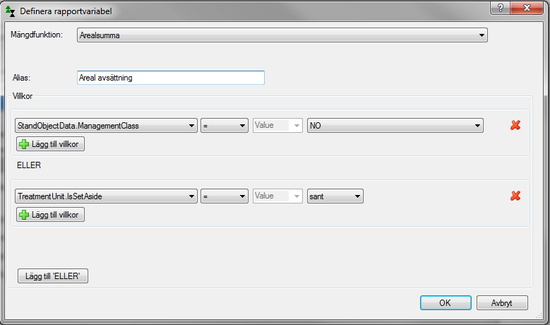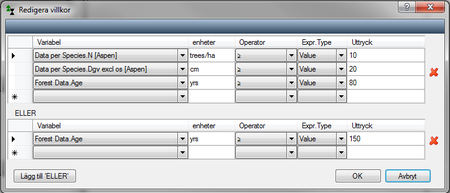Version 2.1.0
Sammanfattning
- Version 2.1 contains several new functions:
- Simulation results can now also be saved in StandWise.
- Storm windthrows can be simulated in RegWise.
- Estimation of root rot occurrence can be calculated.
- The county code (the so called "Dlänskod" as defined by NFI) is calculated autmatically when you import a stand register that contains coordinates. This means that Definition:CountyCode is not mandatory if you have entered coordinates in the stand register for each stand. If you have entered a county code, that county code will be used.
Treatment areas in RegVis
- The models for allocating regeneration, cleaning and thinning activities to stands have been modified so that the obtained areas and volumes vary less between different simulations, and are closer to the calculated or entered target levels.
Save simulation result in StandWise
You can now connect a result database in StandWise and save a simulation. If you open a saved simulation the program will restore the management program based on the treatment codes. Choosing a result database in StandWise is optional.
Modified handling of tree species in thinning configuration
You can now include more than one species group in a thinning group. You do this in control table Treatment Model under Thinning Configuration, and the feature is available when Thinning Model is set to "LOEriksson" or "Hugin". The option "HuginOld" works as before. In previous versions, each species group have been assigned its own thinning specification. In addition, all species groups that you have not defined a thinning specification for, are placed in the same group. The new feature leads to that the choice of thinned trees is more is more determined by tree size than tree species.
Moified handling of tree species in cleaning specification
In the same ways as for thinning (see above) serveral species group can be included in the same cleaning group. You do this in control table Treatment Model under Cleaning Configuration.
Calculation of expected occurence of root rot in Norway spruce
A model for calucating root rot occurence in Norway spruce has been implemented (Thor et al. 2005, see below). The result variables are located in the result group Mortality Data. The result variables are the expected number of infected trees ("Root Rot Stems"), and basal area ("Rot Root Potential Basal Area") and volume ("Rot Root Potential Volume") for these trees. The basal area and volume refer to the whoel trees, not only the infected parts. Currently, timber value losses due to root rot are not calculated.
Model: Thor, M., Ståhl, G. & Stenlid, J., 2005
Inläggning av egna bilder i PlanEval
You can now link your own images to an alternative in PlanEval. Note that PlanEval can be used independently from other Heureka applications ochand that an MCDA problem analysed does not even have to a forestry problem.
Eller-villkor i rapporter
Du kan nu använda "Eller"-villkor i rapporter. Ett praktiskt exempel på användning är om du vill summera arealen generell hänsyn och helt avsatta bestånd (t ex NO-klassade bestånd). Tidigare var man tvungen att göra två olika rapporter för detta.
Läs mer i Heurekas hjälpdokumentation
Eller-villkor i skogsdomäner
Du kan nu använda "Eller"-villkor då du definerar en skogsdomän.
Läs mer i Heurekas hjälpdokumentation
Egen dialogruta för förädlingseffekt i BeståndsVis
När man simulerar en föryngring i BeståndsVis, och planterar med förädlat material, kan man mata in de inställningar för förädlingseffekter som behövs i dialogrutan. Tidigare måste man ange detta i kontrolltabellen TreatmentModel, som är designad för PlanVis och RegVis.
Svårare att "välja fel" beräkningsmodell för föryngring
Lite då och då har användare av misstag råkat välja förynringsmodell = "Database" istället för "Simulation". "Database" innebär att en ungskogsyta hämtas från Hugins ungskogsdatabas och att slumpen spelar stor roll vilken typ av föryngring man får. För att kunna välja "Database" måste du nu aktivt ange i kontrolltabellen TreatmentModel att denna modell ska kunna väljas (parameter "Allow Database Regeneration Model" måste sättas till True)
Buggfix: Snabbare nuvärdesberäkning i BeståndsVis
Nuvärdesberäkningen i BeståndsVis går nu mycket snabbare än tidigare. Felet var att fler slutavverkningsperioder än vad som angetts i kontrolltabellen Treatment Program Generator testades. Felet gäller bara BeståndsVis.
xxx

